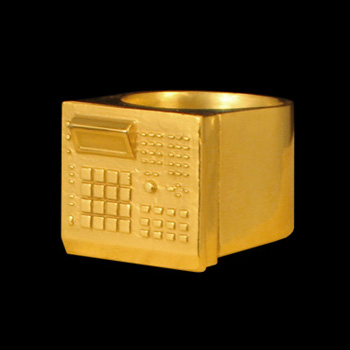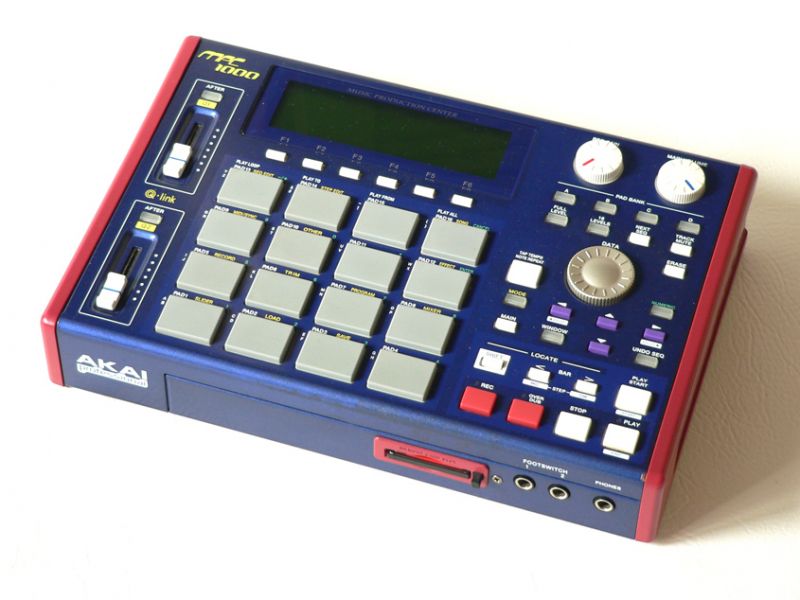The Family
The MPC 1000 is part of a family of samplers made by Akai. It was originally designed by Roger Linn (of the LinnDrum, an early drum machine with high quality drum samples that was used on a ton of recordings in the 80’s). There’s a smaller more portable version, the MPC 500, and a larger version with more capabilities, the MPC 2000. There’s even a brand new version that interfaces with your iPad.
In music, there are always so many different ways to accomplish the same thing, but I’ve always felt it’s important to find the most direct and intuitive technique for you, so that when you are working the ideas can come out as quickly and easily as possible. I like using the MPC for writing beats and sequencing because of the physical nature of the object. I can stand up and move around (I like to bop my head and tap my foot, sometimes I tend to slap my leg with I’m working through a beat…) It’s nice not having to sit and look at a screen. I find that the lack of visual information on the MPC (it just has a very basic two tone window about an inch or two high and a few inches long) allows me to easily enter a visual world of my own that compliments the music I’m working on. Also, it’s nice that I’m not tempted to drift off into the myriad distractions that a computer provides. When I’m working on the MPC I’m ONLY working on making beats. In the rest of my life I’m always multi-tasking and switching between programs, windows, etc…it’s nice to be able to focus on just one thing.
Geometry of Sound
To describe it in the most basic way, the MPC 1000 is a big rectangular-shaped box with a bunch of smaller rectangular-shaped pads on it. The shape of the object correlates nicely with the geometry of a virtual drum sequence. For instance, once you program a sequence you can view it in Track Mute mode, which looks like a grid. In this mode you can mute certain parts of your beat, which show up as darker squares in the grid, isolating the ones you want to hear, and bring the others back in later. Or you can switch back to the main window and play live over top of the previously sequenced track. This sounds relatively simple, but it’s nice to have the ability to continuously add to and change your beat, essentially arranging your song live, if you want. The simplicity of this grid can be helpful in visualizing rhythmic patterns.
Production, Punk Rock, Virtuosity,
The MPC is a music production tool that has been co-opted and turned into an instrument that is often played live. It was originally designed for use in the studio, but people have galvanized it and utilize it as an instrument in all sorts of ways. As with any instrument, there are some incredible MPC virtuosos. There are videos all over You Tube of people showing off their chops. I only mention this because I think it’s common knowledge that on other instruments it’s OK to have a more DIY approach, or a punk rock style. But because the MPC is new-ish, or because it’s electronically based, it has an air of mystique about it. It’s really just a tool though, and can be used however you want. If you wanted to play the guitar and only knew 3 cords that would be enough to be in Wire, or if you wanted to play it upside-down and left-handed you would be Elizabeth Cotten. I think it’s important to remember that the MPC is a means, not an end, and whatever connotations it has all that matters is that it helps you make the sounds you want the way you want to.
The MPC lends itself to DIY software. There are free, simple programs for managing your samples that people make and share online. I use MPC Maid sometimes and another one called MPC Pad 187 to easily manage my samples, create programs (a map of where you want the samples to go on the pads), and interface between the computer and the MPC. You can chop samples and organize them within the MPC itself if you prefer, but I find that manging my samples feels more intuitive on the computer. Part of what I love about the MPC is it’s standalone nature, but that’s also part if it’s drawback. Sometimes the MPC’s built-in software can be a little clunky to navigate. Computers are just better at some things.
Process
Another thing I like about using the MPC is how easy it is to set up the time signature and BPM, which you can easily change later on if your beat is turning into something other than what you’d planned. I love mixing Balkan rhythms, which are often in odd meters, with old school bass sounds, or a bunch of samples of my own voice, or frog sounds, but the MPC is flexible enough to adapt to your music as it’s being made. If what you thought would be a lurching 7/4 beat just sounds better as a 4/4 dance beat, you can change the settings in a second. There’s also a button you can press when you’re holding down a pad that will trigger the sample continuously in a variety of durations (1/8, 1/16 notes, etc). You can also quantize your beats really easily, that is, line each beat up with the click. While a locked groove is totally crucial sometimes, especially if you want people dance, it can be fun to play with/question this idea of mechanical perfection. I’ve accidentally come up with really interesting and surprising rhythmic patterns by playing the pads somewhat randomly and then quantizing. This can put beats in places I never would have chosen. I really value this machine’s ability to surprise me and I think that sense of endless possibility is what makes it fun to play.
Videos
Diana (10 Years old) shows how to switch between sample banks and record multiple tracks:
Araabmusik talks about his relationship to the MPC and demonstrates his live playing skills:
Here are some tracks by Magenheimer that she made using the MPC in a conceptual project called BPP:
http://soundcloud.com/begonia-palacios-pekinpah/sets/everything-little-brother



